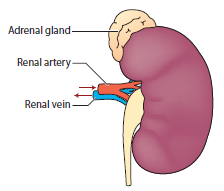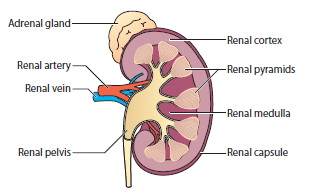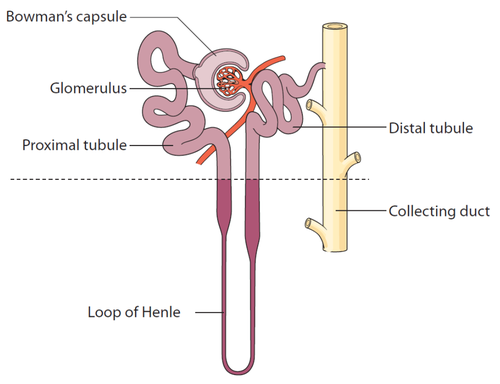If your child has a health condition that affects his or her kidney or another part of the urinary system, you may wish to find out more about these parts of the body.
About the kidney
This section includes information about:
- the adrenal gland, which sits on top of the kidney
- blood vessels going in, around and out of the kidney
- areas of the kidney
- the nephron (which filters blood and makes urine) is made up of the glomerulus and renal tubule
What the kidney looks like
A kidney is reddish and shaped like a kidney bean. One side bulges out (called the convex side). The other side curves in, or is indented (called the concave side).

Our kidneys grow as we get older. Each kidney is about the size of our fist.
Most newborn babies have kidneys that are about 4 centimetres long. When they reach eight years old, their kidney will have grown to about 8 centimetres. Adults’ kidneys are about 13 centimetres long.
Adrenal glands
We have two adrenal glands, one on top of each kidney. (“Ad” means on top of” and “renal” means to do with the kidney.) They are shaped like pyramids.
The adrenal glands help to control how the kidneys work. They make and release chemicals called hormones, which are carried in the blood to send messages to other parts of the body. These hormones are very important with many of the body functions, especially at times of stress such as when we are ill or have an operation.
Blood vessels
Like other parts of the body, the kidney needs blood for everything it does. Blood is pumped around the body by the heart, through tubes called blood vessels.
- The renal artery carries blood into the kidney.
- The renal vein carries blood out of the kidney. These large blood vessels go into the kidney at a dip on its side.
Other smaller blood vessels carry blood around the kidney. These have different names, depending on their size. The smallest of these blood vessels are capillaries.

Areas of the kidney
The kidney has a few different areas. Starting from the outside of the kidney, these are:
- renal capsule – a membrane (like a skin) that covers and protects the kidney
- renal cortex – the outer area
- renal medulla – the inner area, which has about eight sections shaped like triangles called renal pyramids
- renal calyces – these are small areas that collect urine made by the kidney
- renal pelvis – the urine flows from the calyces to this larger area before moving down into the ureter, the tube that leads to the bladder.
Nephrons
Inside each kidney there are about one million nephrons. Nephrons are tiny but very important units that filter blood and make urine. Each nephron has two main parts:
- glomerulus
- renal tubule

The glomerulus
Blood that comes into the kidney flows into each glomerulus, a tight bunch of capillaries (tiny blood vessels). The glomerulus acts like a sieve – some substances from the bloodstream pass through it. When we talk about more than one glomerulus, we say glomeruli.
The glomerulus acts like a sieve – waste and water from the blood pass through the glomerulus.
The space that surrounds the blood vessels of the glomerulus is called the Bowman's capsule, or glomerular capsule.
This part of the nephron is in the renal cortex, the outer part of the kidney (above the dotted line in the image).
The renal tubule
The renal tubule is a long, narrow tube, starting from the Bowman’s capsule. Everything that is filtered through the glomerulus goes into the renal tubule. This liquid eventually becomes urine.
Part of the renal tubule is in the renal cortex, and part of it is in the renal medulla.
The tubule has four sections: proximal tubule, loop of Henle, distal tubule and collecting duct.
Blood vessels
There are tiny blood vessels that go into and out of the nephron, and that surround it.
Read more about the nephron
The wall of the glomerulus works as a filter, letting some substances out and keeping some in – it is called the glomerular filtration membrane. It is quite leaky, and so water and other substances in the blood filter out of the glomerulus. However, blood cells and some proteins are too large to pass through the wall, and so stay in the blood vessels.

The glomerular filtration membrane is like a sandwich with a few layers.
- Endothelial cells are cells are on the inside surface. They have tiny openings called pores that let small substances through.
- The glomerular basement membrane (GBM) is a layer of material around the endothelial cells.
- Podocytes are cells that wrap around the glomerulus. They have long projections that look like feet – sometimes called foot processes. Liquid can filter through the slits between these “feet”.
- Mesangial cells are cells that sit around the glomerulus and support it. They can contract (tighten) to control how much is filtered through the glomerulus.
Renal tubule
The liquid that is filtered through the glomerulus flows along the renal tubule in the order shown below.
- Proximal tubule – this is a coiled-up section next to the glomerulus and Bowman’s capsule (proximal means next to).
- Loop of Henle – this is the next part of the renal tubule. It is a U-shaped section that dips down into the renal medulla. Some nephrons have longer loops of Henle.
- Distal tubule – this is a coiled-up section that connects the loop of Henle to the collecting duct. Because it is further away from the glomerulus and Bowman’s capsule, it is called distal (distant or further away).
- Collecting duct – this is the final section of the renal tubule. It is where urine collects before it flows to the renal pelvis before leaving the kidney.
The renal tubule is lined with tubule cells. These cells help carry substances between the renal tubule and the bloodstream.
Blood vessels around the nephron
There are tiny blood vessels around the nephron.
- Blood goes into the glomerulus through the afferent arteriole (afferent means carried in).
- Blood that is not filtered through the glomerulus leaves through the efferent arteriole (efferent means carried out).
- This blood is then passed into the peritubular capillaries, which surround the nephron.
The kidneys filter blood and make urine (wee). This means that they can:
- remove waste from the body – things that we no longer need or that are harmful
- control the amount of water in the blood, and make sure it has the right balance of chemicals, including salt and acid.
The kidneys also:
- control blood pressure
- help keep bones and teeth strong and healthy
- control the production of red blood cells.